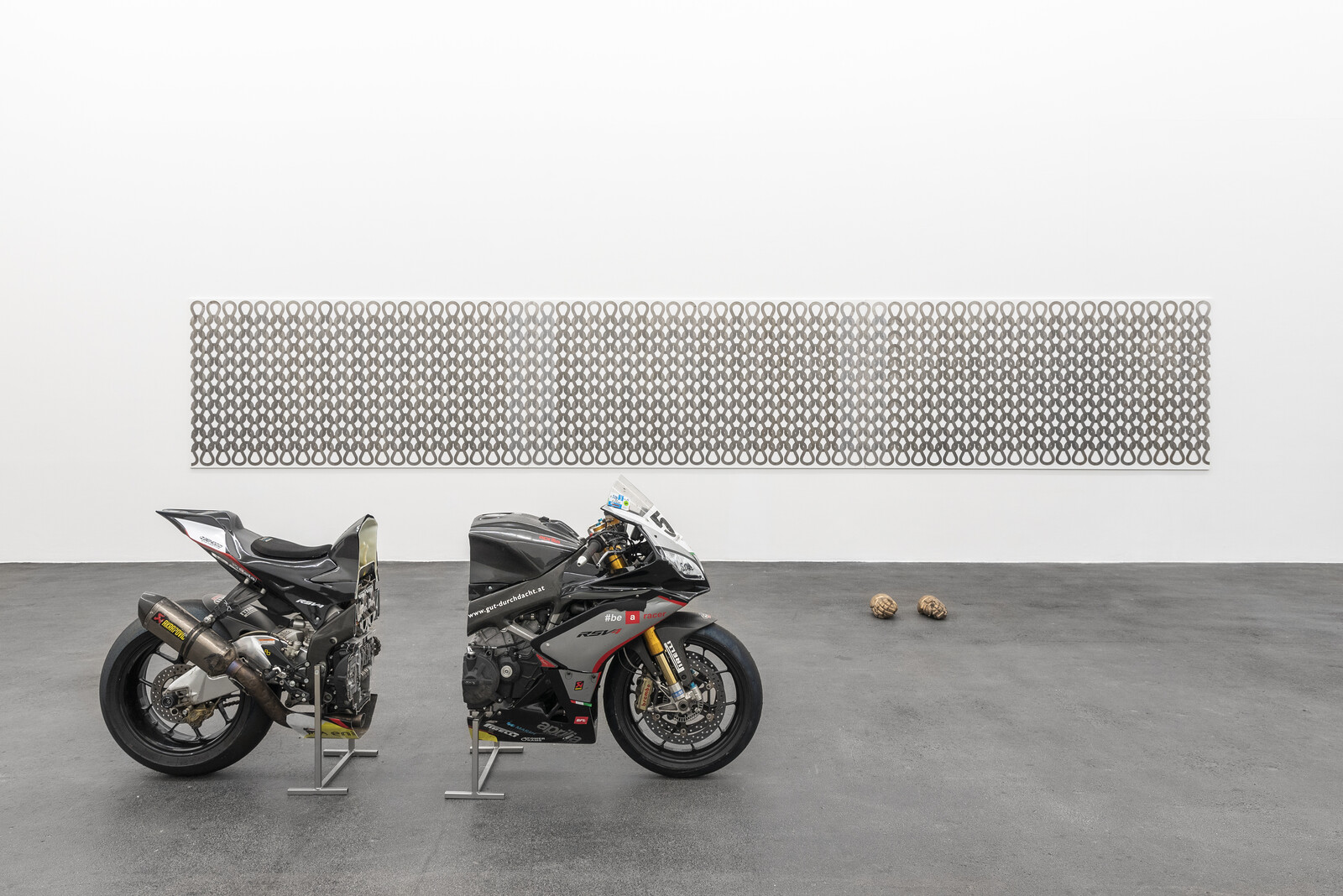Bianca Bondi: Objects as actants
March 12–May 22, 2022
26 quai Aspirant Herber
34200 Sète
France
Hours: Wednesday–Monday 12:30–7pm,
Saturday–Sunday 2–7pm
T +33 4 67 74 94 37
crac@laregion.fr
Alexandra Bircken: A–Z
Alexandra Bircken (born in Cologne in 1967) develops a protean sculptural work that incorporates an unusual range of materials: among them one finds rocking horses, motorcycles sawn in two, but also organic materials like wood, leather, bones and even a placenta, as well as textiles formatted either manually or through mechanical processes.
Anything that surrounds us can become a sculptural medium. Her approach is characterized by an examination of the human body, its needs, desires, and relationship to its environment. Highly topical questions such as the need for protection of the individual, gender identity in its ambivalence, and the relationship between humans and machines are taken up and thematized in Bircken’s sculptures.
This exhibition is the largest solo show of the artist and brings together works from throughout her practice: from the first sculpture completed in Bircken’s store-front studio Alex in Cologne in 2003 to the work entitled Slip of the Tongue, created for public space in 2020, which welcomes visitors in front of the building. Rather than proceeding chronologically, this show uses themes and formal concepts to progress through the artist’s oeuvre, attempting to capture her sculptural repertoire of forms from “A–Z”: from Bircken’s exploration of textiles to the relationship of the human body to its environment and to her vibrant and organic seeming machines.
The exhibition A–Z by Alexandra Bircken was conceived in collaboration with the Museum Brandhorst in Munich, where the exhibition was presented from July 28, 2021 to January 16, 2022 (curator: Monika Bayer-Wermuth).
Bianca Bondi: Objects as actants
Between fairytale and apocalypse, Bianca Bondi’s installations and sculptures plunge the viewer into a universe both strange and familiar, where past, present and future intermix. As if in a waking dream or inner drift, her works suspend the boundaries between the astral and earthly worlds, realms of the living and the dead, the visible and invisible. Working in connection to the exhibition site, its aura and its secret archaeology, Bianca Bondi proposes custom-made landscapes for the spaces in which she intervenes.
For over a decade, she has been using ephemeral and organic materials like wax, plants, spirulina, spices and especially salt, which has become her material of choice, both for its strong symbolism and its chemical properties. Present in religions as well as in spiritual and pagan practices, it is associated with a protective function, and repels the evil eye.
What could seem like a gradual destruction of objects in Bianca Bondi’s work stems rather from the potential for transformation and regeneration. The artist even speaks of an “energy transfer” between the elements. Thus her installations are undergoing a constant metamorphosis: one can see copper objects covered in bluish stains, clothing invaded by crystals, water that slowly oscillates between purple and crimson.
In the context of a multi-week residency at Paul Valéry Highschool in Sète, the artist worked with students, undertaking to retrieve abandoned objects from the city’s canals, sometimes buried in the mud. A rope, a landing net and other everyday objects were cleaned. Already significantly altered by the flowing water and by marine organisms, these objects constitute the matrices of sculptures presented on the walls. Like poetic enigma, they are transfigured by the action of salt and the addition of plants.
The installation that Bianca Bondi is producing specifically for the first floor of the Crac Occitanie is the fruit of a three-week residency, in partnership with La cité scolaire Paul Valéry in Sète. It is a new work-experiment conducted through a close collaboration between the Crac’s visitor services and the teaching staff at La Cité scolaire
Curator: Marie Cozette
What is Crac Occitanie?
Located in Sète, on the bank of Canal Royal in the heart of the city, the Crac Occitanie overlooks the port and the Mediterranean Sea. Its architecture’s exceptional volumes reflect the industrial nature of the building, which was originally a refrigerated warehouse used for the conservation of fish. In 1997, architect Lorenzo Piqueras renovated the original building, giving it the current configuration and transforming it into an exceptional exhibition site, offering 1,200 square meters of gallery space distributed over two floors.
The Crac is dedicated to artistic creation. It offers a programme of temporary exhibitions, publishes exhibition catalogues and artist books, and develops a dynamic cultural and educational programme for all audiences, through guided tours, workshops, lectures, concerts, performances and more.
The Centre Régional d’Art Contemporain is managed by the Région Occitanie / Pyrénées-Méditerranée. It receives support from the Ministry of Culture and aid from the Occitanie region’s prefecture and DRAC.



